Raya and the Last Dragon
March 13, 2021 · 0 comments
By Andrew Osmond.
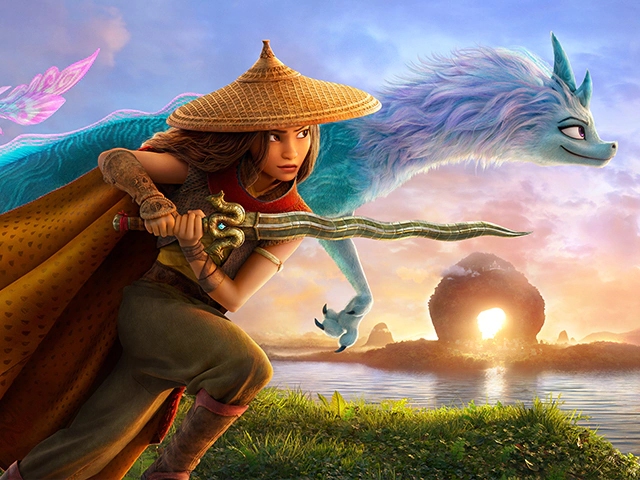
The newest Disney feature animation, Raya and the Last Dragon, is available on the Disney+ platform. At the moment, it’s the same deal as the live-action Mulan had when it debuted. To see the film, subscribers must pay an extra “Premier Access” fee of £19.99, though you can rewatch Raya as much as you want after that. The film will be available to standard subscribers on 4th June.
Raya is a down-the-line action-adventure fantasy, which is itself unusual for a Disney animation. There’s comedy, of course, but it serves the action and it’s markedly less goofy than most Disney toons. There are no songs, and lots of fighting. There’s no apparent love interest for the heroine, though there’s already hooha on that front – we’ll get to that later.
The film is also loaded with much more backstory than most Disney cartoons, though the Frozen films went heavy. Raya has two backstories, though they’re delivered painlessly; for how that kind of storytelling can go wrong, see Disney’s megaflop John Carter. The first prologue involves a centuries-old magic war. Benign serpentine dragons save humanity from shapeless cloud monsters called Druun, which turned their victims to stone. The colourful 2D style of this sequence, with characters like jointed puppets, recalls the indie animation of Nina Paley – here’s an (adult) sample of her work.
The second prologue introduces us to Raya, daughter of the chief in Heart, one of five lands sundered in the earlier battle. Heart is the resting place for a giant orb that’s the last remnant of the dragons, who are seemingly no more. Thanks to its possession of the Orb, Heart is viewed with suspicion by its neighbours. Raya’s father invites delegates from them all to a feast, hoping for peace and unity. During this time, young Raya bonds with Namaari, heiress to Fang, one of the other lands. Raya and Namaari are both dragon nerds, and at first it seems the story will be about the girls’ friendship.
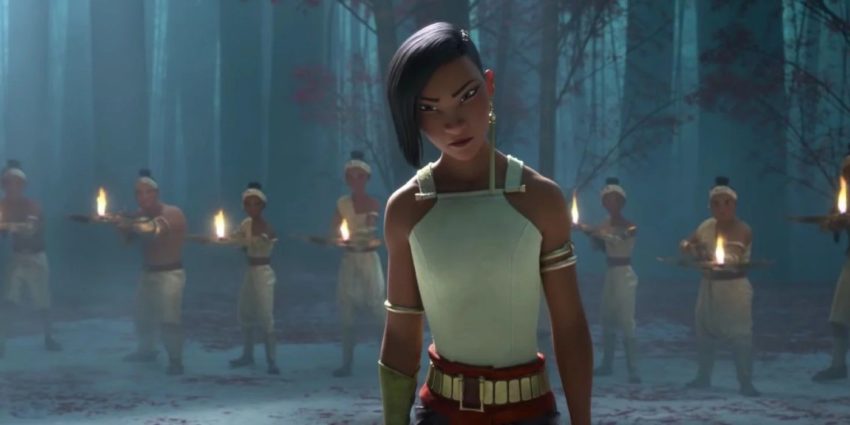
It doesn’t happen that way. Namaari betrays Raya, leading to a battle where Heart’s orb is broken. The Druun monsters catastrophically return, laying waste to all around them… and then there’s a six-year time-skip to the story proper. What I’ve described covers the first twenty minutes of a 95-minute film, excluding credits.
A quest followed, with an older, angrier Raya travelling the lands, looking for the pieces of the orb. But she’s also seeking Sisu, the dragon that wielded the orb centuries ago, and who’s rumoured to be still around. Raya no longer believes in peace; she just desperately hopes Sisu and the orb can save the Druun’s victims, including her father. And Raya does find Sisu; a very innocent, scatter-brained dragon with a limited understanding of people. Her personality is like Dory from Finding Nemo; her voice is like a softened Joan Rivers.
The story is about Raya’s and Sisu’s interplay, which is important even by the standards of “buddy” cartoons. At heart, it’s a film about an injured, angry girl and an older, kinder, wiser mother figure. Following Disney tradition, Raya’s real mum is dead and wiped from the script, but the female relationship is one of the most distinctive things about the film. I can’t think of any other cartoon film that’s foregrounded such a relationship, anime included.
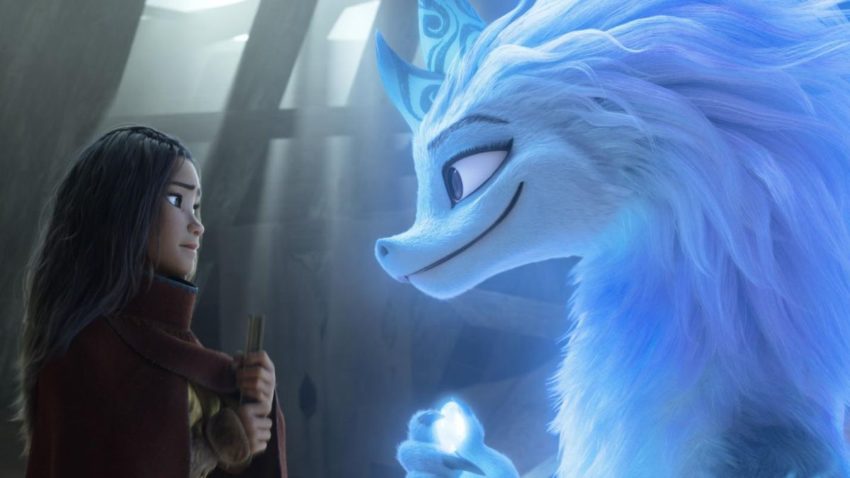
Raya and Sisu – who adopts a practical human disguise – travel the lands, picking up allies. They periodically run into Namaari, Raya’s former friend and now sworn nemesis. It’s very much an action picture, full of fights and chases – there’s an especially good chase through a river town, dashing over bridges and leaping over boats. And wait till you see the rogues who Raya’s chasing.
There are early nods to Indiana Jones and Mad Max – Raya gets a meta-line about “a lone rider, a dystopian world” – but they fade before long. There are also, of course, the fights between Raya and her rival Namaari. These are mixed – the girls look great when they’re fighting with weapons, but there’s a set-piece confrontation when they’re unarmed, and it’s sped-up and rubbery.
The Raya-Namaari storyline itself feels sped up. It makes sense, just about, but the motivations and emotions feel disappointingly threadbare. In fact, Raya is like the kind of film that anime fans know well – a compressed retelling of a TV-length series. Raya doesn’t feel like anime, but it does feel like American TV cartoons that drew openly on anime, especially in their character conflicts. I’m thinking of Airbender and the She-Ra reboot.
While She-Ra was probably too recent to have influenced Raya, fans have already pointed out overlaps between Raya and Airbender. Both are action-adventures set in Asian-flavoured fantasy worlds, with conveniently demarcated nations for the heroes to travel to. They also have adversaries (Raya’s Namaari, Airbender’s Zuko) with elaborate story arcs.
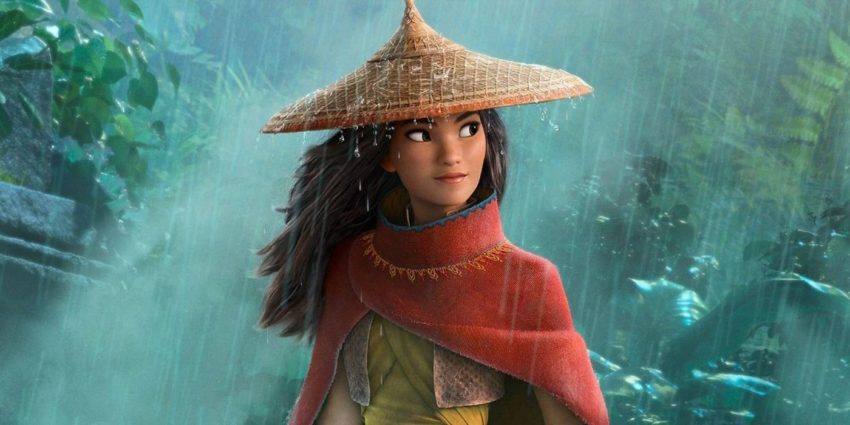
Lots of fans have compared Raya’s costume in her first scene to the garb of Airbender’s Water tribe. You might also compare Raya’s giant mount Tuk Tuk (who’s basically an enormous pill bug) to the flying bison Appa in Airbender, who was himself partly inspired by the Cat-bus in Totoro. It could all be coincidence, but to me the Raya–Airbender link feels closer to Lion King–Kimba (solid) than Atlantis–Nadia (silly).
Either way, I felt Raya’s story – and especially the tale of Raya and Namaari – was better suited to a TV serial than a 95-minute film. Of course, then it wouldn’t have had the pleasures of a full-milk blockbuster, and Raya, unsurprisingly, looks wonderful. There’s some great cartoon acting – for instance, the expressions of Raya and her dad during their stricken farewell on a bridge. The sight of the serpentine Sisu doing backstroke in a river is sensuous and funny.
But the spectacle feels compressed, too, even compared to other American cartoon films. Sisu’s flying scenes are happy, but don’t have time to develop their wonder; compare this scene from Disney’s Rescuers Down Under or this from DreamWorks’ How to Train Your Dragon. Raya is an enjoyable, predictably sumptuous film which never rivals Disney’s best.
Still, this modest film has been pulled into angry arguments. It reflects how Hollywood animation is scrutinised by today’s pundits and social media, as part of the blockbuster mainstream. As such, Raya’s getting more think-pieces than any anime, or the next “real” film by Scorsese or Fincher.
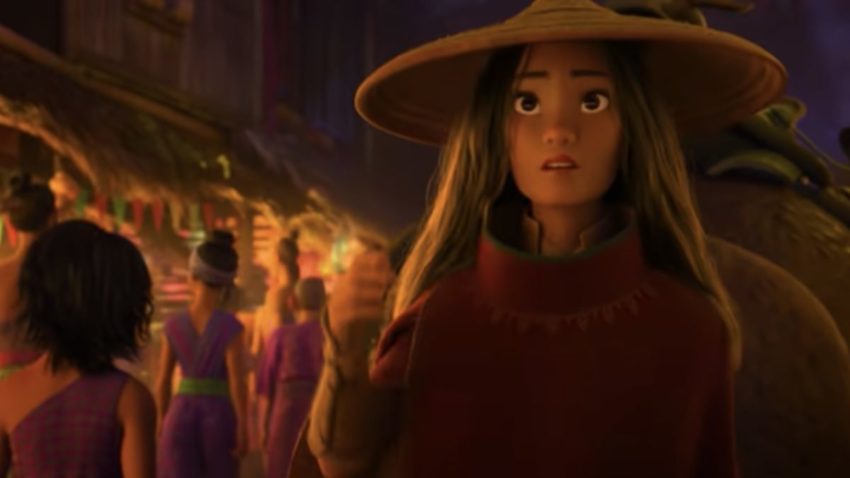
One argument around Raya involves ethnicity. There’ve been Asian protagonists in past Disneys – the Chinese heroine in Mulan, the Japanese-American Hiro in Big Hero 6. However, Raya was promoted as the studio’s first film based on South East Asia. Its world is a fantasy, but blends details from real countries: a hat from the Philippines, a sword from Indonesia. This has led to a torrent of vexed articles, asking if Raya’s reducing a region of 673 million people and eleven countries to so many Easter Eggs.
If nothing else, it warns against anyone thinking of doing a mix’n’match fantasy of foreign cultures in 2021. No-one complained about Airbender in the 2000s, when it bunged in cultures from China to Greenland. Or Miyazaki’s mash-up Europe in Kiki’s Delivery Service. Are Europeans too privileged to be offended?
There’s a related row over Raya’s voice cast, with complaints that many of the actors are East Asian, not South East Asian. This places Raya next to the other casting controversies of the day, from “gayface” to the rows over white cartoon actors voicing outside their skin colour – here’s a well-publicised case involving a South East Asian character. I’ve yet to see an article calling for English anime dubs to use Japanese actors for Japanese characters, but it’s the “logical” next step.
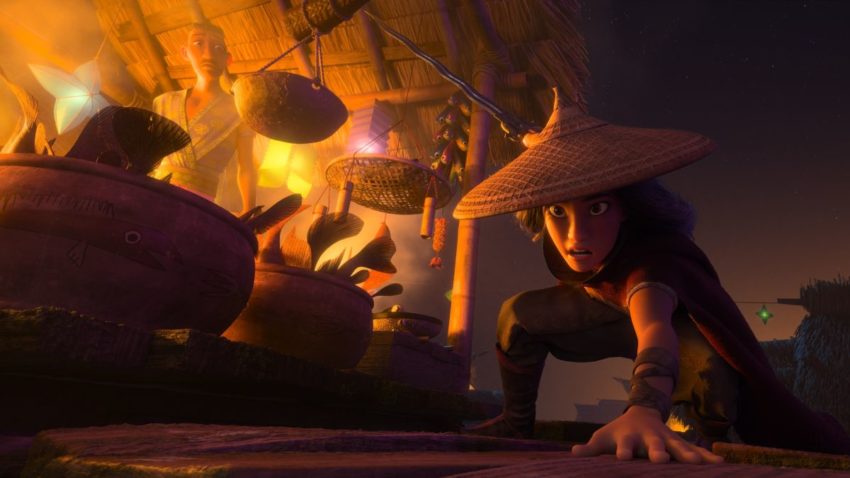
Then there’s an entirely separate argument about Raya, this one over gay representation. As I mentioned earlier, Raya ostensibly has no love interest in the film. However, her actress Kelly Marie Tran has “outed” Raya as gay, as reported in a long piece in Vanity Fair. On her reading, Raya’s real romance in the film is with her frenemy Namaari. Tran, it seems, is straight; perhaps Russell T. Davies will call for her voice in Raya to be replaced by a gay actor’s! Still, Vanity Fair suggests Raya is guilty of queer-baiting for not confirming its heroine is gay on screen.
The same article attacks anime. Dana Terrance, who created Disney’s recent TV cartoon The Owl House, is quoted as saying she sees queer-baiting in “a lot in modern anime… Like the show is almost making fun of viewers for becoming invested in a relationship that they’ve [the show’s creators] decided to build up with no intention to pay it off.” Terrance didn’t name names; maybe she’s seen Kyoto Animation’s work.
Her comment raises gnarly questions – for example, what counts as pay-off and who gets to decide it. When I interviewed Shinichiro Watanabe for this blog, he suggested it didn’t matter if characters were gay or straight. But Vanity Fair suggests fan voices have more weight than creator ones. Remember, we’re in a world where fans war on creators. It’s happening now with J.K. Rowling; it happened with Rian Johnson, director of the Disney-produced The Last Jedi. Only with Jedi, the fans didn’t just go for Johnson. They also attacked the actors, being horribly vicious towards… Kelly Marie Tran, who’s now the voice of Raya.
As a film, Raya and the Last Dragon is perfectly good, but it’s of limited interest. As a case study in modern culture wars, it may be far more fascinating.
Andrew Osmond is the author of 100 Animated Feature Films.
Leave a Reply